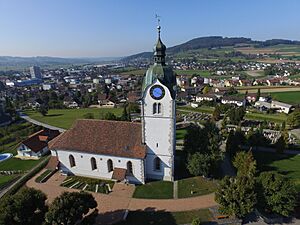Reinach, Aargau facts for kids
Quick facts for kids
Reinach
|
||
|---|---|---|
 |
||
|
||
| Country | Switzerland | |
| Canton | Aargau | |
| District | Kulm | |
| Area | ||
| • Total | 9.47 km2 (3.66 sq mi) | |
| Elevation | 528 m (1,732 ft) | |
| Population
(Dec 2020 )
|
||
| • Total | 8,874 | |
| • Density | 937.1/km2 (2,427.0/sq mi) | |
| Postal code |
5734
|
|
| Surrounded by | Beinwil am See, Birrwil, Gontenschwil, Leimbach, Menziken, Pfeffikon (LU), Rickenbach (LU), Zetzwil | |
Reinach is a town in the canton of Aargau in Switzerland. It is part of the Kulm district.
Contents
History of Reinach
People have lived in the area around Reinach for a very long time. Scientists have found tools from the neolithic period (New Stone Age). There are also old burial mounds from the Hallstatt culture and buildings from the Roman era. Even graves from the Alamanni people have been found.
Reinach was first mentioned in records in the year 1036. Back then, it was called Rinacha. A powerful family, the Lords of Reinach, owned a lot of land here. In 1572, Reinach became its own independent town, separate from Menziken.
Church and Community Life
Before the Protestant Reformation in 1528, Reinach was part of a different church area. After the Reformation, Reinach got its own church. This church was built in 1528–29. Other nearby towns like Menziken and Beinwil am See were also part of this church community for a while.
Growth and Industry
Reinach has always been a place for trade. As early as the 14th century, there were mills and a tavern. In 1588, Reinach was allowed to hold markets, which helped the town grow.
In the 16th and 17th centuries, people in Reinach started weaving canvas fabric. Later, from about 1850 to 1970, Reinach became a big center for making tobacco and cigars.
In 1904, a special train line called the Wynental- und Suhrentalbahn connected Reinach to Aarau. This made it easier for people and goods to travel. In the 20th century, many metal companies also opened in Reinach.
Geography of Reinach
Reinach covers an area of about 9.47 square kilometers (about 3.66 square miles). A large part of this land, almost 45%, is used for farming. About 27% of the area is covered by forests.
The town itself, with its buildings and roads, takes up about 28% of the land. There are also some rivers and streams.
Reinach is located in a valley called the Wynental, which is named after the Wyna river.
Reinach's Coat of Arms
The blazon of Reinach's coat of arms shows a red lion standing on its hind legs. The lion has a blue head and tongue, and the background is gold.
People of Reinach
Reinach has a population of about 7,979 people (as of 2010). Many people in Reinach speak German, which is the most common language. Other languages spoken include Albanian and Italian.
Age Groups
In Reinach, about 9.9% of the people are children aged 0 to 9 years old. Teenagers, aged 10 to 19, make up about 12.7% of the population. This means Reinach has a good mix of young people and adults.
Homes and Families
Most homes in Reinach have 3 or 4 people living in them. On average, there are about 2.4 people per household. In 2008, about 29.9% of the homes were single-family houses.
Education
Many adults in Reinach (aged 25–64) have finished high school or gone on to higher education like university. In the 2008/2009 school year, there were over 500 students in primary school and over 200 students in secondary school in Reinach. There were also many students attending university-level schools.
Economy of Reinach
In 2007, the unemployment rate in Reinach was low, at 2.85%. This means most people who wanted to work had jobs.
Reinach has different types of jobs:
- Primary sector: This includes jobs like farming.
- Secondary sector: This includes jobs in factories and manufacturing, like the metal industry.
- Tertiary sector: This includes jobs in services, like shops, offices, and healthcare.
Many people who live in Reinach also work in other towns. At the same time, many people come into Reinach from other places to work. Most people use private cars to get to work, but some also use public transportation.
Religion in Reinach
According to a census from 2000, about 28.5% of the people in Reinach were Roman Catholic. About 45.2% belonged to the Swiss Reformed Church.
Notable Residents
Many interesting people have lived in Reinach, including:
- Adolf Fischer (1807–1893), a politician.
- Willi Gautschi (1920–2004), a historian.
- Markus Hediger (born 1959), a writer and translator.
- Herbert Müller (1940–1981), a racing driver.
- Philipp Müller (born 1952), a politician.
Images for kids
See also
 In Spanish: Reinach (Argovia) para niños
In Spanish: Reinach (Argovia) para niños














